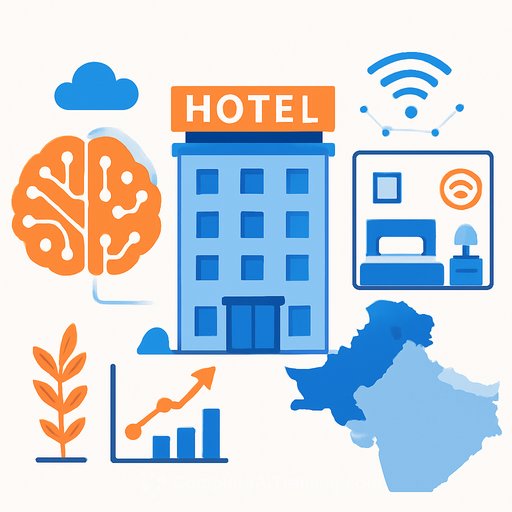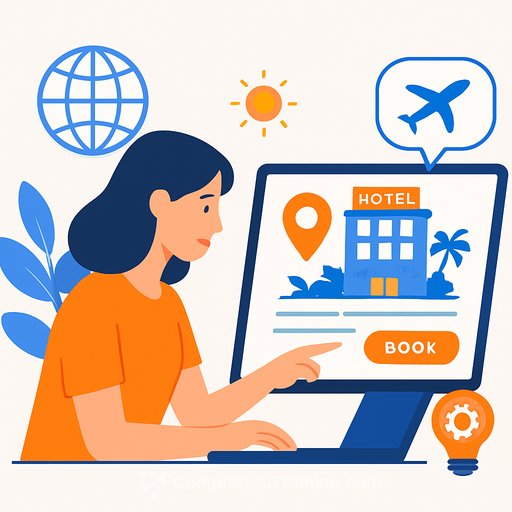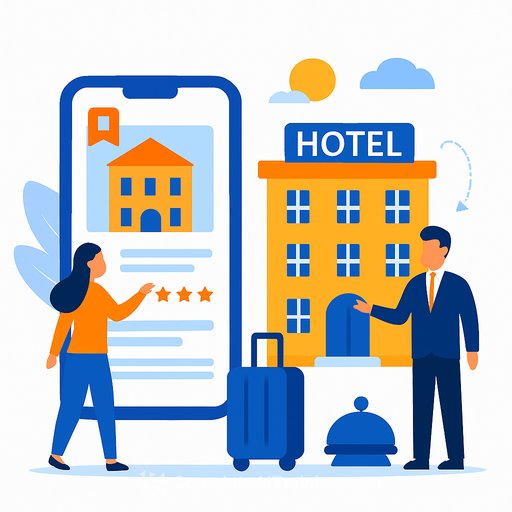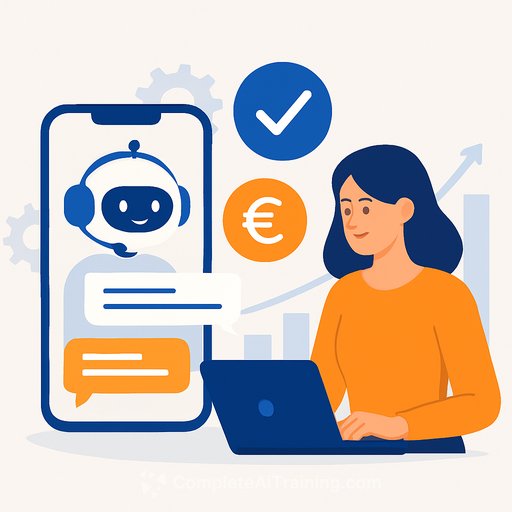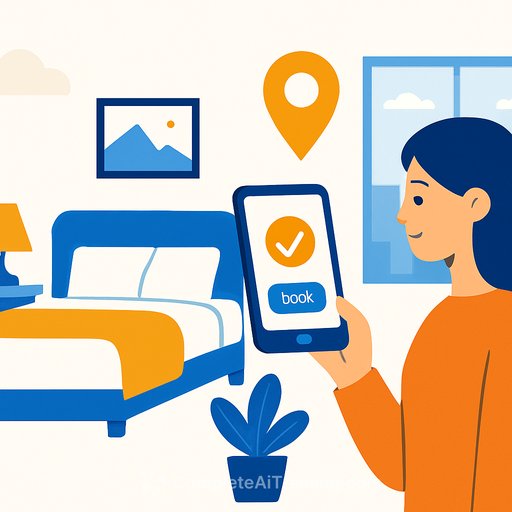Hospitality Technology Trends 2026: AI, Smart Rooms & Revenue
Technology now sits at the center of hotel performance. By 2026, guest expectations, cost pressure, labor limits, and sustainability goals will make tech a core part of strategy, not an add-on.
Use this guide to prioritize what matters, act quickly, and measure results. You'll find clear steps, fresh context, and a practical focus on Pakistan and South Asia.
1) AI and automation: from guest service to operations
AI has moved from pilots to plans. Nearly 9 out of 10 hoteliers expect to deploy AI around 2026 across guest messaging, pricing, and operations.
Reality check: Fragmented systems block value. Until data flows across PMS, CRM, revenue, and service tools, you won't get end-to-end personalization or automation. Today, only about half of properties report mostly integrated toolsets.
- Start small, scale fast: Pilot an automated check-in and basic request flow. Track response times, CSAT, and ancillary sales.
- Hit measurable ops use cases: Predictive maintenance to cut downtime; AI scheduling to reduce labor cost per occupied room.
- AI readiness checklist: Confirm PMS/CRM have open APIs, clean guest data, and event streams you can access in real time.
Why this matters: AI removes repetitive work so staff can focus on higher-value, human moments. Revenue teams adjust pricing in minutes, boosting RevPAR. Predictive maintenance prevents emergency spend.
2) Smart rooms and IoT at scale
Smart rooms drive personalization and lower utility bills. Market signals point to strong growth in smart hospitality as IoT and connectivity improve.
- Prioritize quick payback: Start with occupancy and energy sensors in high-use areas to reduce HVAC and lighting waste.
- Avoid vendor lock-in: Choose modular devices with open standards and standard APIs.
- Test before you roll out: Offer a small smart-room block as a premium upsell and measure uptake.
- Track energy savings from smart HVAC and sensor-based lighting.
- Reduce maintenance emergencies with predictive alerts.
- Improve satisfaction with remembered preferences and simple mobile or voice control.
3) Unified tech stacks and real-time analytics
Disjointed stacks dilute the value of every other tech investment. Unified systems unlock personalization, faster service, and better decisions.
Here's the gap: even with AI plans, many hotels still run disconnected systems. One industry forecast notes only about 54% report mostly integrated tools. Integration comes first.
- Map everything: Inventory PMS, CRS, CRM, POS, housekeeping, payments, guest apps, and connectors.
- Prioritize by revenue and guest impact: Integrate PMS↔CRM↔revenue engine first, then POS and guest apps.
- Use middleware: An integration platform with open APIs cuts custom dev time and risk.
- Percent of unified guest profiles across systems.
- Time to resolve guest requests with data available to staff.
- Conversion uplift on targeted ancillary offers.
4) Contactless and mobile guest journeys
Mobile check-in, digital keys, in-app ordering, and mobile payments are shifting from "nice-to-have" to baseline for many segments. In several markets, up to 70% of guests say they'll use app or kiosk check-in over the front desk.
- Roll out to loyalty and direct first: Test flows, fix friction, then expand.
- Keep a human fallback: Train staff for hybrid service to match guest preference.
- Integrate payments end to end: All spend should land on the folio without manual reconciliation.
- Shorter front-desk queues and faster resolution times.
- Higher ancillary revenue from in-app ordering and timely offers.
- Improved satisfaction among mobile-first guests.
5) Sustainability and wellness tech as business levers
Sustainability reduces costs and meets guest expectations. Energy management, waste reduction, and wellness features are gaining traction because they make financial sense.
- Start with LED retrofits and smart controls in heavy-use areas. Paybacks are typically fast and easy to measure.
- Deploy water and energy dashboards. Visibility changes behavior and guides investment.
- Offer wellness features with modest cost: portable air-quality monitors, sleep program partnerships, and curated in-room content.
- kWh saved per occupied room and utility cost per available room.
- Guest satisfaction on wellness and sustainability attributes.
- Gross margin improvement from lower utilities.
For broader context on building efficiency practices, see the International Energy Agency's coverage of energy efficiency in buildings. IEA overview.
6) Revenue innovation, payments, and ancillary services
Hotels are selling more than rooms: memberships, day-use, experiences, and packaged add-ons. Modern payment options, including digital wallets, reduce checkout friction and boost upsell conversion.
- Integrate POS with your guest app: Keep orders, payments, and folios in sync.
- Pilot a membership: Weekend access, co-working with discounted stays, or F&B bundles for frequent locals.
- Time offers with data: Promote spa/dining to guests who previously booked them.
- Ancillary revenue per occupied room (ARPOR).
- In-app offer conversion and average order value.
- Repeat purchase rate among members/subscribers.
Geo-focus: Pakistan and South Asia
South Asia has strong upside for hospitality tech-if you plan for local conditions and payment habits.
- Opportunities: Mobile-first users, fewer legacy systems to replace, and growing domestic tourism support fast pilots.
- Challenges: Internet reliability, power interruptions, and complex payment mixes (global cards plus domestic wallets).
- What to do now: Pick cloud vendors with regional support and offline modes. Integrate domestic wallets first to maximize conversion, then layer global rails. Pilot with one property, measure KPIs, and scale regionally.
For context on mobile adoption and digital wallets in the region, explore GSMA's Mobile Economy resources. GSMA Mobile Economy.
If your team needs structured AI upskilling by role, see these focused resources: AI courses by job.
Implementation roadmap and checklist
- Audit (month 0-1): Inventory systems, integrations, cost centers, and guest touchpoints.
- Pilot (months 2-6): Run 1-2 pilots (e.g., mobile check-in and an energy retrofit). Track KPIs.
- Integrate (months 6-12): Connect PMS, CRM, and revenue systems for real-time decisions.
- Scale (year 1-2): Roll out pilots with proven ROI across properties or room types.
- Optimize (ongoing): Keep measuring satisfaction, energy savings, and revenue.
- Immediate checklist: Prioritize one integration. Launch a mobile check-in pilot. Retrofit LEDs and occupancy sensors in public spaces. Start collecting clean guest preferences in your CRM.
Common risks and how to mitigate them
- Fragmented systems: Choose vendors with open APIs and use middleware to reduce custom work.
- Data security: Set clear data governance, encrypt payments, and align your privacy policy with local regulations.
- Staff resistance: Communicate the "why," provide role-based training, offer incentives, and share early wins.
FAQs
What technology will have the biggest impact in 2026?
AI paired with unified data. Without integrated systems, AI can't personalize or automate at scale.
How much should a mid-sized hotel budget for tech upgrades?
Focus spend where it stops revenue leakage and shortens guest handling time. Fund pilots from quick savings and scale once KPIs are met.
Are smart rooms worth it for smaller hotels in Pakistan?
Yes-selectively. Start with high-ROI items like smart thermostats and occupancy sensors. Offer smart rooms as a premium category before retrofitting the entire property.
Will contactless service reduce guest satisfaction?
It can for guests who want personal service. Offer hybrid flows and keep staff available for a warm welcome on request.
How fast do tech investments pay off?
Small pilots like mobile check-in can show results in months. Full integrations and energy retrofits often take 12-36 months for full ROI.
What are the most common implementation mistakes?
Buying tools without an integration plan, skipping staff training, failing to track KPIs, and choosing vendors without local support.
How do hotels increase ancillary revenue effectively?
Use guest data to time relevant offers and keep ordering and payments inside one app with one-tap purchase.
Conclusion
In 2026, value comes from strategy, integration, and measurement. Connect your systems, pilot AI where the impact is clear, build mobile guest journeys that actually get used, and invest in staff skills.
For Pakistan and South Asia, mobile-first behavior and the chance to leapfrog legacy tech create a real advantage. Audit now, run tight pilots, integrate the core stack, and scale the winners. The next 18 months will reward operators who move with focus and follow the data.
Your membership also unlocks:

